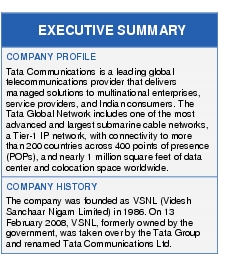

Challenge/Opportunity
• In a diverse environment of vendors and carriers, interoperability is critical, and Tata is working with its partners to address this. For example, Tata has announced a commitment to deliver multiscreen interoperability between Cisco, Tandberg, and other third-party systems by releasing its Telepresence Interoperability Protocol (TIP) as an open standard. This open standard is a good start for the video industry, but there is much more work to be done in providing the full interoperability that is required by enterprises.
• Several questions still remain on the business models and commercial agreements around international telepresence services. The revenue distribution for traffic across multiple telecommunication providers' networks is still a work in progress, and some confusion can be expected around who owns the customer's relationship in some particular cases.
• Although video is becoming a strong application in enterprise communication, it is unlikely to replace all voice applications and communication use cases. High-definition (HD) video collaboration will continue to be an advanced service that will co-exist with other business communications services.
Alliances/Partnerships
• Tata's telepresence and video collaboration strategy is underpinned by its networks capabilities and based on a technology partnership with Cisco, which was established in 2008.
• Tata was one of the first telcos to partner with other telepresence exchange operators to enable inter-carrier connections. Its GMX alliance partnership program allows Tata's partners to offer global B2B services beyond their home markets. All customers on the GMX can dial into the partners' home markets for extended reach.
• The Intercarrier Exchange connects rooms on the networks of Tata Communications' Inter-Exchange partners, BT and Telefonica, and the National Lamda Rail network, which links leading U.S. universities. These telcos have taken advantage of their video conferencing experience to drive the managed telepresence market globally, and are now relying on this partnership with Tata to extend reach and further drive intercompany video.
• Tata was the first company to offer public rooms, which are extended through partnerships with local telcos and hotel groups, such as the Taj Hotel Resorts and Palaces and Starwood Hotels.
• Tata also has a partnership with GetThere, a global provider of travel and collaboration management solutions, to provide access to public and private telepresence rooms for GetThere's customers who want to meet virtually. This partnership helps to promote adoption of the technology and extends the geographical coverage of the platform beyond the corporate network. A global network of public rooms may give MNCs (multinational corporations) a better range of options and help them to justify the investment.
• Other partnerships include Amex, which integrates telepresence services as an option within its existing travel planning portfolio. Telepresence is integrated into its virtual meetings solution, and public suites are available at various locations including some Marriott, Starwood, and Taj hotels. According to Amex, "The virtual meeting exchange platform is currently available through an offline reservation desk and is expected to be available online in 2011."
Strategy

Success Factors/Metrics/Monetization
• Tata Communications aims to be among the leading providers of global/multiregional services to MNCs. Tata's leading position in Global Meeting Exchange services is a key element in this strategy. Tata has moved from an Indian-centric telco (in 2006, more than three-quarters of the company's revenue came from India) to a relatively well-balanced business distribution across the globe, although India is still its largest market and now accounts for 37 percent of revenue.
• At this stage, Tata does not disclose figures about the services revenue or number of active customers. However, the increasing number of partners joining its GMX alliance and the growing number of customers are clear signs that the strategy is paying off. Recent customer contracts include:
– Car manufacturer PSA Peugeot Citroen: private telepresence rooms. Tata says it is the first car manufacturer to use a high-definition, virtual collaboration tool to connect its research and development facility with its executive offices around the world, reducing time for product development through better collaboration. Five rooms installed across three locations: France (3), Brazil (1) and China (1).
– Starwood Hotels & Resorts Worldwide: public telepresence rooms. Starwood now has a total of eight public telepresence rooms available globally across seven locations in Germany (2), France (1), Canada (1), United States (1), Australia (1), and Kuwait (1).
Company Background
• Read Tata Communications overview
Case Study Source: Cisco sponsored research developed by Ovum
